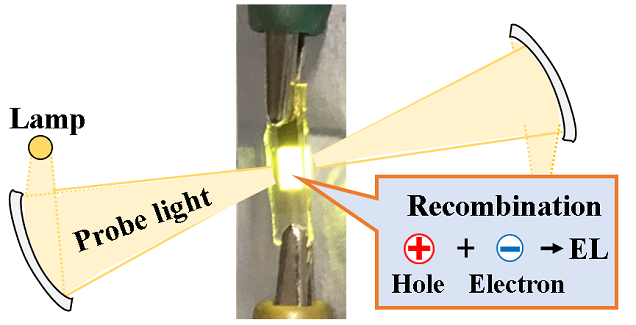The generation of light by an electrical current without the need for heat or chemical reactions is known as electroluminescence. Due to this, electroluminescent lights are dependable and extremely effective; their use ranges from digital watches to the displays of the Apollo space shuttle’s guidance computers.
 Electroluminescence measurement experimental setup. Lamp light passes through the light-emitting electrochemical cell (LEC), driven by square wave bias, to observe signal absorption using spectrophotometry. Electroluminescence (EL) generates light when electrons recombine with electron holes, shedding excess energy in the form of photons. Image Credit: Osaka Metropolitan Universiy
Electroluminescence measurement experimental setup. Lamp light passes through the light-emitting electrochemical cell (LEC), driven by square wave bias, to observe signal absorption using spectrophotometry. Electroluminescence (EL) generates light when electrons recombine with electron holes, shedding excess energy in the form of photons. Image Credit: Osaka Metropolitan Universiy
Light-emitting electrochemical cells (LECs), which generate light via electroluminescence, have seen significant technical developments similar to OLEDs. Detailed investigation of the mechanisms that lead to luminescence is critical for enhancing luminescence efficiency; however, there has been no experimental approach for directly analyzing these processes.
By measuring their optical absorption through lamp light irradiation, a research team led by Professor Katsuichi Kanemoto from the Graduate School of Science and the Nambu Yoichiro Institute of Theoretical and Experimental Physics at Osaka Metropolitan University has successfully observed changes in the electronic state of LECs over time during field emission.
Their research was published in Nature Communications and chosen for the Editors’ Highlight. The review article on single-molecule reaction dynamics in solution, which was pioneered by nanofluidic devices, was published by researchers in the January 2023 issue of TrAC Trends in Analytical Chemistry.
The overview offers a bird’s eye view, encompassing the forefront of research and development, impending obstacles, and where these new findings could lead.
Recombining electrons with electron holes—regions that could hold an electron but do not have them—causes electroluminescence. A photon of energy is released when an electron enters the hole. The findings of the analysis showed that LECs had a two-step luminescence mechanism.
- Once the voltage is applied, holes in the LEC are produced instantly, and the layer that accommodates these holes expands closer to the interface with the electron-side electrode before recombining with a few electrons to produce the electroluminescence.
- The amount of electroluminescence then stabilizes as the layer that can tolerate electrons expands over time at a pace equivalent to that of the hole layer’s retraction.
The spectroscopic observation method used in this study is applicable not only to the LECs but to all light-emitting devices, including OLEDs. Using this technique, we expect to reveal the details of the electroluminescence process and furthermore, it will lead to the early detection of processes that interfere with device operation. In the future, we will strive to shorten the measurement time of our system to create a rapid device diagnosis system.
Katsuichi Kanemoto, Professor, Graduate School of Science, Osaka Metropolitan University
Funding
The Osaka City University (OCU) Strategic Research Grant 2017 for basic research and the JSPS KAKENHI Grant (17H03135) both contributed to the funding of this study.
Journal Reference:
Yasuji, K., et al. (2023) Visualizing electroluminescence process in light-emitting electrochemical cells. Nature Communications. doi:10.1038/s41467-023-36472-6